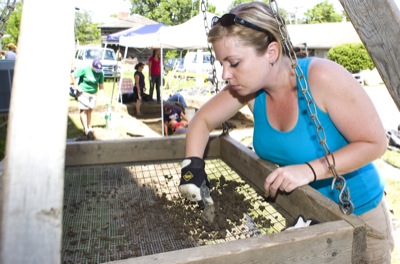Tuesday, June 14th, 2011
State sets algae toxin standards
Protocol includes toxin benchmarks, advisory levels, public notice requirements
By Nancy Allen
GRAND LAKE - Boating will never be restricted on state waters due to algae, according to new protocol.
Three new water advisories either warn of an algae bloom, caution the public of health issues or advise against no contact with the water. None warn against boating or eating the lake's fish.
Grand Lake St. Marys State Park Manager Brian Miller said it's a relief to have the new strategy in place.
"I like the idea that we are no longer going to impact boating and fishing no matter what the advisory level is so we can have special events on the lake like fireworks and the Governor's Cup," Miller said. "So that is a huge plus."
Also, a no contact advisory would be placed only if a human illness or pet death has been reported and algae toxins levels are at or above 20 parts per billion (ppb). The state formerly used World Health Organization standards, which placed a no contact advisory only based on the 20 ppb test level. Grand Lake had a no contact advisory most of last summer.
Since May 19, the lake has been under the new public health advisory, which is posted when tests show microcystin toxin levels are at least six ppb. The public is advised against swimming, wading, swallowing the water and not having any contact with surface scum.
An algae bloom advisory will be posted for a recreational contact area once a bloom has been identified and the state has confirmed it as an algae capable of producing toxins. The public would be advised not to ingest water and avoid contact with surface scum.
If a no contact advisory is issued, the state would recommend avoiding all contact with the water at that location.
"First we will only post (advisory signs) at beaches, which are places people would typically recreate," said Heidi Griesmer, Ohio EPA spokeswoman. "If we see algae out in an open area of the lake, then we may test a larger area to determine if an 'open water no contact advisory' should be posted."
Griesmer said the state would decide open water advisories on a case-by-case basis.
Microcystin levels in samples pulled last week from Grand Lake ranged from 3.3 to 23.7 parts per billion. The results of water samples pulled Monday will be posted on the Ohio EPA's website at
ohioalgaeinfo.com under the 'Advisory List' later this week.
Buckeye Lake in Licking County is the only other Ohio body of water with an advisory; its beaches are under an algae bloom advisory.
The new protocol also says if toxins are found above acceptable thresholds in the treated drinking water of a public water system, a drinking water advisory will be issued.
Celina's treated drinking water is safe and has consistently tested non-detect for algae toxins, water treatment plant superintendent Mike Sudman said this morning.
The lake is the city's sole source of drinking water. Lake water is run through an extensive treatment system, including carbon filtration, before it is used by the public.
The state will issue news releases when a no contact advisory is posted. All advisories will be listed on the Ohio EPA's website at
ohioalgaeinfo.com.
An ongoing alum treatment on Grand Lake is on schedule and should be done June 30, said Tadd Barrow of HAB Aquatic Solutions, the Nebraska company doing the application.
Local officials hope the treatment will lessen toxic algae blooms this summer. The state says repeated alum treatments will be needed in coming years to keep the lake's algae at bay.
Barrow said lights were added to the boat so it could apply at night due to low dissolved oxygen levels in the morning. Low dissolved oxygen levels can stress fish and other aquatic life.
"We were starting at 6 or 7 a.m. each day but the dissolved oxygen wasn't coming up until 10 or 11 a.m.," Barrow said. "So because we are missing a few hours of daylight application, we are making it up at night."
The first night application was Monday, he said.
"We are well lit up at night," Barrow said. "You can't miss us."
Keeping safe:
Here are a few common sense things families can do to stay safe this summer while enjoying Ohio's waterways:
• Before you go to a beach, check the state's website
ohioalgaeinfo.com to see if an algae advisory has been posted.
• If you're at a beach and you see surface scum or something that looks like blue-green algae, report it to Ohio EPA by e-mailing HABmailbox@epa.ohio.gov.
• Be alert and avoid unusual water conditions, especially in areas with floating green scum or general discoloration. Use common sense: when in doubt, stay out.
• Immediately rinse family members, pets and yourself after swimming in natural waters.
• Swallowing any source of untreated water is unsafe, so never allow your family members or pets to drink lake or river water.
- Source: Ohio EPA
